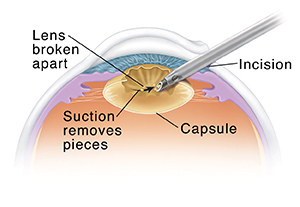You may be surprised by how little time small-incision cataract surgery takes.
The procedure
Your surgeon uses a microscope and tiny tools to make the incision and remove the old lens. A special tool breaks apart the old lens with sound waves (ultrasound) and then takes out the pieces. This process is called phacoemulsification. The natural membrane (capsule) that held your lens is left in place. Your old lens will then be replaced with a clear artificial lens.
Incision size
A smaller incision may mean a shorter recovery time for you. The location of the incision will vary.
Featured in


